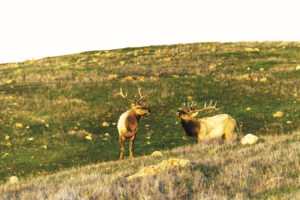Planners designing a strategy for one of the biggest wetlands recovery projects ever undertaken in this country—the South Bay salt pond restoration—want to hear what folks like you and your neighbors have to say about it. You may have ideas about how the project can achieve its goals of creating habitats for a rich diversity of birds and animals, bolstering flood protection for low-lying urban neighborhoods and opening up new levee-top trails and wetland waterways for the public to explore. Specifically, you may be picturing a bird-watching blind, a hiking trail, or a kayak launching dock in the marsh close to your home. Or wondering whether the new levees will be as strong as the old ones or if new wetlands will spawn swarms of mosquitoes. Or worrying that sensitive nesting plovers will be disturbed by the increased foot and two-wheeled traffic. Whatever your concerns or questions, restoration planners are ready to share information and to listen.
But first, go see the restoration site for yourself. Docent Eileen McLaughlin says that her favorite spot on the Bayfront Park tour is a lookout point where you can see the lush marsh of Mountain View’s Greco Island and a salt pond side by side. “Here’s where the challenges and opportunities of the restoration are most apparent,” she says. Another highlight is a short side trip down to the edge of a salt pond where you can touch or even taste the salt that encrusts the banks, watch brine flies skittering along the water’s surface, and spot tiny orange brine shrimp swimming near shore. Those interested in a more virtual tour can arrange for a speaker to give a slide show at their workplace, school, or community center.
Once you’re up to speed, you can attend one of any number of stakeholder meetings, work group meetings, and large public workshops. Steve Ritchie, who is managing the restoration project for the California Coastal Conservancy, says, “The most useful thing that folks can do is to make themselves heard.”
Now is the time to get involved, as planning for the restoration is under way. The plan will operate on the concept of “adaptive management”; it will be broken down into phases, and the first phase will be much better defined than the later ones. Scientists know very little about how to return a completely transformed shoreline to some semblance of its former marshy self; so, they’ll monitor the first restoration phase thoroughly from the start, and the lessons learned will guide work on the later phases.
Once the plan has been completed (scheduled for 2008), you can lend a hand with the actual on-the-ground restoration and maintenance work; there will be far too much of it for paid public employees to handle alone. The project’s lead scientist, Lynne Trulio, says that they’ll need help planting native grasses and shrubs, weeding out invasive plants, and leading tours. They may also need help with counting birds, testing water quality and overseeing habitat development. In fact, local residents like you will have to be stewards for the marshes, to help them grow and flourish—well, forever.
To jump into all this, you’ll need to know who’s in charge and who’s involved in what tasks. That may be a challenge, because there are so many agencies and institutions working on the restoration. As Clyde Morris of the U.S. Fish and Wildlife Service (FWS) explains, “It’s a huge project so a lot of people have to be involved. It makes things time-consuming, but it’s worth the effort”.
Guiding the process is a Project Management Team made up of staff from three lead agencies: the California Coastal Conservancy, the U. S. Fish and Wildlife Service, and the California Department of Fish and Game (DFG). The latter two agencies actually own the salt ponds and are gradually taking over management from Cargill Salt. The conservancy, meanwhile, oversees contracts with all of the consultants, technicians, and scientists.
The team’s job is a balancing act, says member Carl Wilcox of DFG. “The biggest problem we face is how to provide public access that’s compatible with wildlife habitat. How much access to provide, and where, could become major debates.” Another challenge will be to manage the vast amount of scientific research needed to inform the restoration effort. “We have to figure out how much it will cost and where we can get all of that money,” says Ritchie.
The team has pulled together a number of expert groups to advise them. Picture the team as the earth and the groups as satellites circling around it and beaming information and ideas back home. The satellites come in three types: government advisers, scientific consultants, and the public.
On the government side, an Executive Leadership Group, made up of heads of the three core agencies on the team, meets from time to time to address stubborn issues. When regulatory disputes arise, an Executive Council, composed of staff from state environmental agencies, advises the team. To engage neighbors, a Local Government Forum pulls in officials from South Bay cities. Paula Bettencourt of Mountain View Community Services says, “The salt ponds are our neighbors. Local elected officials and city staff need to stay in good communication with the team to understand how the restoration will impact their cities.”
On the research side, 16 local scientists have been entrusted with ensuring the plan is scientifically sound. Lead scientist Trulio says, “The science team’s role is to identify what we do and don’t know and to figure out what we need to know.” Trulio adds that a National Science Panel, with seven wetlands experts who have managed large projects in other regions, will oversee the local scientists and “provide a sort of peer review.” Finally, various technical consultants will assess environmental impacts and design the restoration.
On the public involvement side there’s the Stakeholder Forum. Its 29 members represent community organizations, business interests, environmental groups, and local government. This forum has regular meetings that are open to the public, and also breaks down into work groups on public access, habitat restoration, flood control, and funding.
Members say that participating in a work group takes time but definitely makes a difference. Longtime Alviso resident George Trevino, who has seen his neighborhood under water from time to time, says that the flood control work group brings up lots of information that influences planning, such as how waterways have changed over the years, which levees have silted up and which ones have flooded the most.
The habitat work group has also left its stamp on the plan. Member Melissa Hippard, of the Sierra Club, says that her group persuaded the team to add the least tern to the restoration plan’s list of protected species. While the least tern isn’t deemed a threatened or endangered species, local birders have noticed its numbers dwindling.
According to the Bay Institute’s Marc Holmes, a member of the funding work group, the group’s job couldn’t be more critical. He says, “We’re figuring out how to make a case to Congress and the state for getting the kind of money that other projects—like the Everglades restoration—have gotten. The salt ponds restoration could cost millions every year for decades, so this is a major task.”
Next on the agenda is the task of sketching out up to 10 alternatives for the restoration; then, over the next year or so, the project team will zero in on the best one.
A first stab at defining these alternatives will take place in fall 2004. After that, the team will look at the alternatives from every imaginable angle—migratory bird protection, predator control, nuisance species management, sediment availability, and flood protection, for example—to narrow them down to the five or six best approaches. Next, the state and the feds will dissect the alternatives through their formal environmental review process and by late 2005 will suggest a “preferred” approach. During the next two years, engineers will draft blueprints, and the team will dot the i’s and cross the t’s with permitting agencies. It will also line up enough money to cover phase I at least. Dirt, mud, and water won’t start getting moved around in a big way till 2008.

.jpg)



